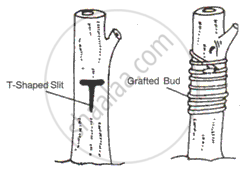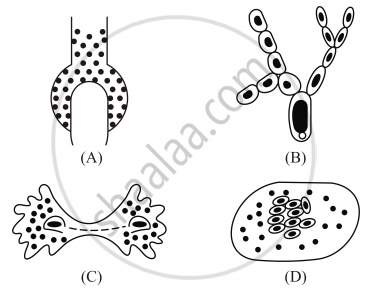Advertisements
Advertisements
प्रश्न
उत्तर
The methods by which plants can be vegetatively propagated artificially are
(i) Cutting - In this method, stems are cut into pieces and planted in the soil. This is the easiest and most frequently used method of artificially propagating plants, Eg. - Sugarcane, grapes, rose, etc.
(ii) Layering - Here, an intact branch is bent into the soil and is covered with moist soil. The growing tip remains above the soil. When roots arise in the branch region in contact with soil, it is separated from the parent plant. Within a few weeks, a new plant can be propagated by this method. Eg. - Cherry, jasmine, and grapevine

(iii) Grafting - Here a detached part of one plant called scion is inserted into the stem of a rooted plant called stock. Scion is a short piece of detached shoot containing several buds. Stock is the lower portion of the plant fixed in the soil. The scion is cut and placed face to face with stock. After a few days, a vascular connection is established between the joined parts and parenchyma tissue develops at the junction of the graft. Eg. - Apple, pear, mango, guava.

(iv) Budding - Here a single bud instead of a branch is grafted on the stock. In about two weeks, the bud unites with the stock after which the stock just above the bud is cut off. Eg. - Lemon and hibiscus

APPEARS IN
संबंधित प्रश्न
On cutting the body of an organism into many pieces it was observed that many of these pieces developed as new individuals. Name the process and list two organisms in which this process may be observed. Draw a schematic diagram to illustrate the changes that are likely to be observed during the development of new individuals in any one of the organisms named.
How will an organism be benefited if it reproduces through spores?
The stem of a fruit tree X fixed in soil is cut in a slanting way. The upper part of stem of another fruit tree Y of different variety of same species is also cut in a slanting way. The cut stem of tree Y, without roots but having some leaves, is placed over the rooted cut stem of tree X in such a way that their cut surfaces fit together properly. While joining the two cut stems, care is taken to make sure that the layer Z of one cut stem is in contact with layer Z of the other cut stem. The joint of cut stem is bound tightly with a piece of cloth and covered properly with polythene. Soon the cut heals and the two stems grow together and become one fruit tree producing leaves, flowers and fruits.
(a) What is the name of this method of producing plants or trees?
(b) What name is given to the cut stem of tree X having roots?
(c) What name is given to the cut stem of tree Y which has no roots but has some leaves?
(d) Name the layer Z.
(e) Why should the layer Z of one cut stem be in contact with the layer Z of the other cut stem?
(f) Name any four fruit trees which are usually bred by this technique.
(g) State any one advantage of producing fruit trees by this technique.
With the help of suitable diagram, describe Budding in yeast cell.
Mention the common method of reproduction in Mosses.
What is fragmentation in organisms?
Binary fission is observed in which one of the following figures?

List in tabular form two differences between binary fission and multiple fission.
Give the name of the plant that reproduces vegetatively by: Underground stem
Identify the type of reproduction from the following explanation and draw a neat and labelled diagram.
- The body of the parent organism breaks up into many fragments and each fragment starts to live as an independent new organism.
- Give two examples of living organisms which follow this type of reproduction method.
